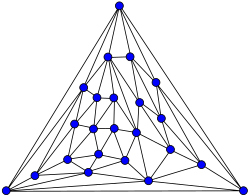Kittell graph
Planar graph with 23 vertices and 63 edges From Wikipedia, the free encyclopedia
In the mathematical field of graph theory, the Kittell graph is a planar graph with 23 vertices and 63 edges. Its unique planar embedding has 42 triangular faces.[1] The Kittell graph is named after Irving Kittell, who used it as a counterexample to Alfred Kempe's flawed proof of the four-color theorem.[2] Simpler counterexamples include the Errera graph and Poussin graph (both published earlier than Kittell) and the Fritsch graph and Soifer graph.
References
Wikiwand - on
Seamless Wikipedia browsing. On steroids.

